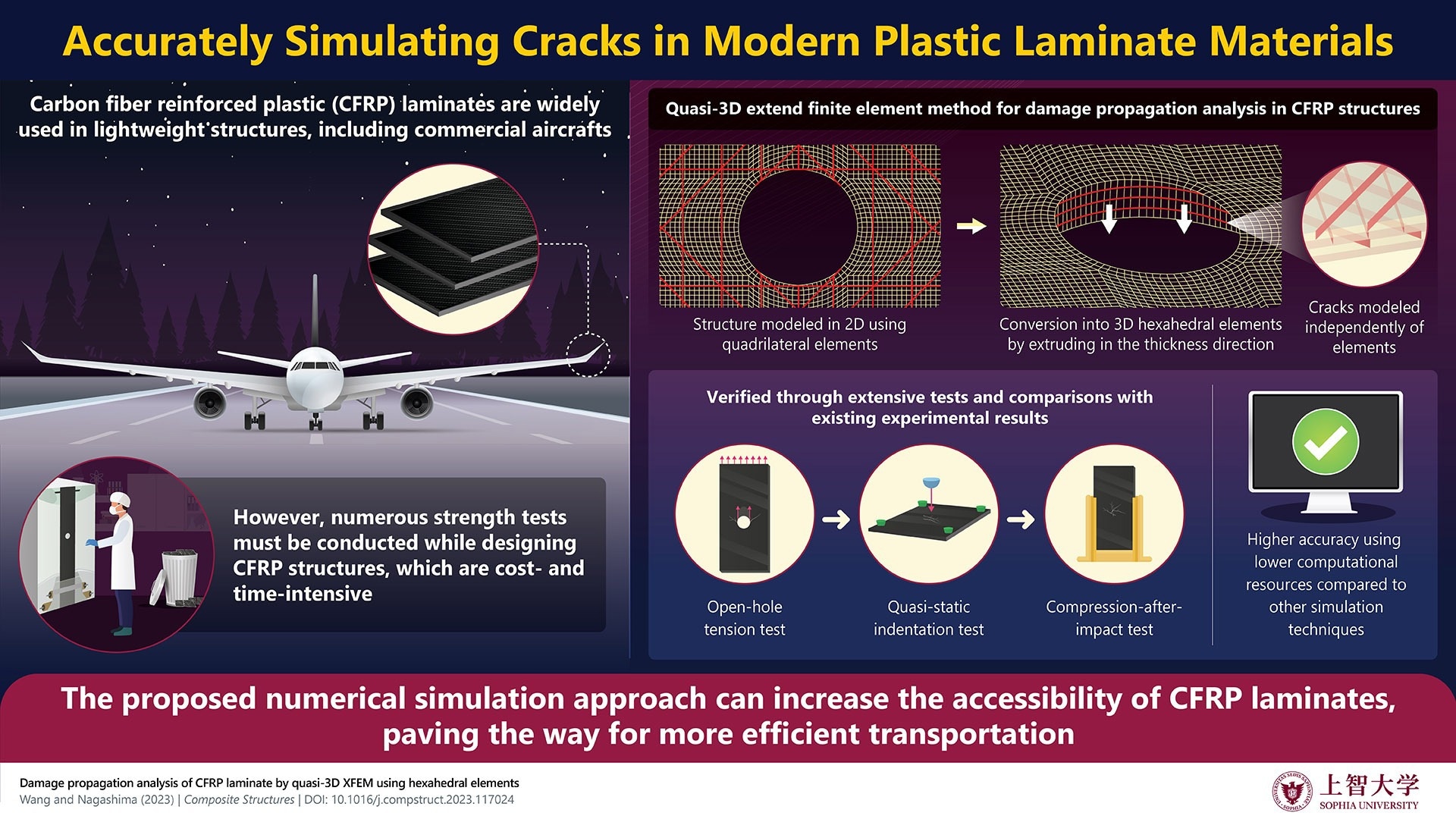Carbon fiber reinforced plastics (CFRPs) are lightweight materials that are strong and durable, with applications in aerospace and transportation. Despite their potential, research and development tends to be time-consuming and costly.

Image Credit: Sophia University
Researchers recently developed a quasi-3D extend finite element method, a novel and computationally efficient method for simulating damage propagation in CFRP laminates. Their technique may make CFRP laminates more available.
Applications for structural materials with beneficial mechanical properties can be found in many different industries. Creating structural materials lighter without compromising their strength is a tried-and-true method of improving their characteristics. Carbon fiber reinforced plastics (CFRPs) are perhaps the most recognizable application of this strategy.
These materials are plastics, held together by a matrix of tiny but powerful threads of carbon atoms. Modern aerospace applications, transportation, and construction use CFRP laminates because of their low weight, excellent durability, and superior mechanical performance.
On the other hand, creating CFRP laminates can take a lot of time. Whenever engineers change a particular design, they must perform numerous strength tests to compare CFRP specimens. This raises the cost of the finished product and prevents the use of CFRPs in a wider range of industries.
In light of this, Professor Toshio Nagashima of Sophia University and Dr. Chenyu Wang, a former Ph.D. Student at the Graduate School of Sophia University, collaborated to create a novel approach for numerical simulations of damage propagation in CFRP laminates. On April 13th, 2023, their research was published in the journal Composite Structures.
The approach was based on a quasi-3D version of the extend finite element method (XFEM). In FEM, a structure or material is divided into tiny subregions known as elements, and the overall response of the system is calculated by solving physical equations for each element.
The “extend” version, which was employed in this study, includes functions that capture local effects near discontinuities and enables more precise modeling of damage propagation in the form of crack growth.
Since CFRP laminates are made of stacked layers of material, modeling them as flat planes (2-dimensional or 2D) would miss anomalies like delamination. A 3-dimensional (3D) FEM simulation, on the other hand, would be computationally intensive and difficult to set up. The investigators used a balanced approach to tackle these challenges.
Researchers modeled the desired CFRP laminate as a 2D structure made up of quadrilateral finite elements and marked the locations where cracks could form. The structure was then projected in the thickness direction, while the models used to simulate delamination and matrix crack were generated automatically by their simulation system.
This strategy made the computations more manageable, as well as the modeling to simulate CFRP damage easier and more efficient.
To validate their method, the investigators carried out simulations of three different strength and damage propagation tests on CFRP laminates and matched their results to experimental data from other studies. The first was an open-hole tension test, which involved pulling a CFRP laminate with a circular hole in the middle from one end while anchoring the other.
The second test was a quasi-static indentation (QSI), in which a hard semi-sphere was slowly and steadily pressed against a CFRP laminate. Finally, the third test was the compression-after-impact test, which involved subjecting the damaged specimens from the QSI test to a compressive force to evaluate their integrity and damage tolerance.
On the whole, the proposed simulation method's results agreed well with the experimental data and outperformed the current quasi-3D XFEM-based techniques.
The applications of composite materials such as CFRP will become more extensive and efficient if the results of this study are utilized in related fields.
Dr. Chenyu Wang, Former PhD Student, Graduate School, Sophia University
The widespread use of CFRPs is also likely to have significant environmental consequences.
In the future, if the damage of composite materials can be predicted more efficiently and accurately via numerical simulations, their cost will decrease. If these lightweight and high-strength materials are further applied in transportation, it will have a positive impact on energy savings and environmental protection.
Dr. Chenyu Wang, Former PhD Student, Graduate School of Sophia University
The cost of flying could be significantly reduced if commercial aircraft could reduce fuel consumption and design time by incorporating CFRPs.
Journal Reference:
Wang, C., & Nagashima, T. (2023). Damage propagation analysis of CFRP laminate by quasi-3D XFEM using hexahedral elements. Composite Structures. doi.org/10.1016/j.compstruct.2023.117024.
Source: https://www.sophia.ac.jp/eng